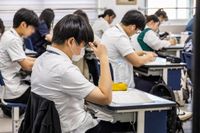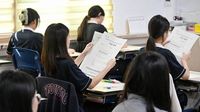On June 4, 2025, the Korean Institute for Curriculum and Evaluation (KICE), the official body responsible for administering the College Scholastic Ability Test (CSAT), conducted the June mock exam for the 2026 academic year. This nationwide examination was held simultaneously at 2,119 high schools and 511 designated academies across South Korea, beginning promptly at 8:40 a.m. The exam's timing was slightly shifted from its original schedule on June 3 to avoid clashing with the 21st presidential election day, underscoring the nation's commitment to both education and democratic processes.
KICE announced that this year's mock exam was meticulously designed to ensure that differentiation among students could be achieved solely through content covered in public education, without relying on ultra-difficult, so-called 'killer questions' that often favor students with intensive private tutoring. This approach aligns with the broader goal of normalizing high school education and reducing disparities caused by private education advantages.
In its official 'June Mock Exam Questioning Direction' released on the morning of the exam, KICE emphasized that the questions were crafted to measure abilities learned exclusively through the high school curriculum. "We aimed to structure the exam in accordance with the content and level of the high school curriculum to accurately assess the competencies acquired through school education," KICE stated. Importantly, the institute excluded questions that would advantage students who had honed problem-solving techniques through repetitive private education training.
The exam maintained a balanced difficulty level across all subjects to ensure fair differentiation. Rather than employing extreme difficulty questions, KICE focused on core and fundamental content, which it described as essential for the normalization of high school education. Even when reusing previously released material, the institute modified question formats, concepts, and approaches to keep the test valid and reflective of current educational standards.
Subject-wise, the exam leveraged diverse materials and passages within the curriculum's scope for Korean and English language sections. For mathematics, social studies, science, vocational exploration, and second foreign languages including Chinese characters, the questions were designed to assess critical thinking skills, tailored to the unique characteristics of each subject. This approach reflects a shift from rote memorization to evaluating students' analytical and reasoning abilities.
Addressing concerns about fairness in elective subjects, KICE took deliberate steps to minimize any potential advantage or disadvantage arising from students' subject choices. This was achieved by carefully calibrating questions to balance difficulty and content across different elective options.
Another significant feature of this mock exam was the linkage rate with the Educational Broadcasting System (EBS) materials, a critical component of South Korea's public education resources. The overall EBS linkage rate stood at approximately 50% based on the number of questions per subject and area. Specifically, Korean language had a linkage rate of 51.1%, mathematics 50%, and English 55.6%, with Korean history and elective subjects maintaining a consistent 50%. The linkage was indirect, involving the use of concepts, principles, passages, core topics, or arguments, or by modifying and reconstructing questions to reflect EBS content appropriately.
This indirect linkage method means that while the exam content aligns with EBS materials, it avoids direct repetition, instead encouraging students to apply their understanding in varied contexts. This strategy supports both the integrity of the exam and the educational value of EBS resources.
The June mock exam's design reflects a broader policy trend to reduce the influence of private education on student performance in national assessments. By excluding 'killer questions' and focusing on core curriculum content, KICE aims to create a more equitable testing environment that rewards genuine learning over test-taking strategies acquired through private tutoring.
Students taking the exam on June 4 experienced a test environment shaped by these principles. The simultaneous administration across thousands of schools and academies ensured a uniform testing experience nationwide, reinforcing the exam's role as a key benchmark for university admissions and academic achievement in South Korea.
Reflecting on the exam's intent, KICE noted, "By focusing on core and basic content, we hope to contribute to the normalization of high school education." This statement underscores the institute's commitment to fostering an educational landscape where public schooling provides the foundation for academic success, rather than private education serving as a gatekeeper.
In summary, the 2026 CSAT June mock exam marks a continued effort by South Korea's education authorities to balance fairness, rigor, and accessibility in one of the nation's most consequential academic assessments. By aligning closely with the public curriculum, excluding ultra-difficult questions, and maintaining a substantial but indirect connection with EBS materials, KICE is steering the CSAT towards a more equitable future.





